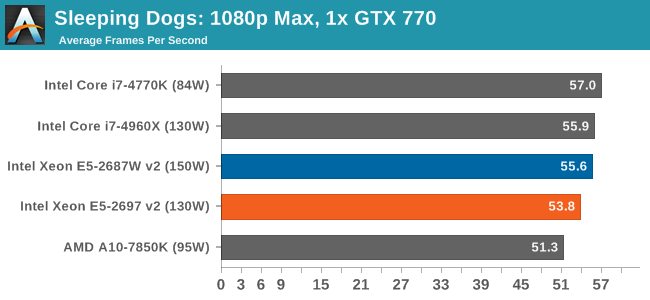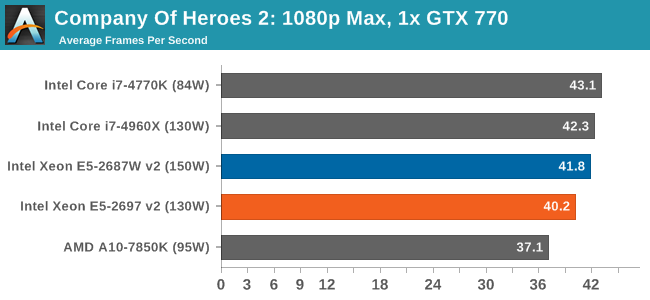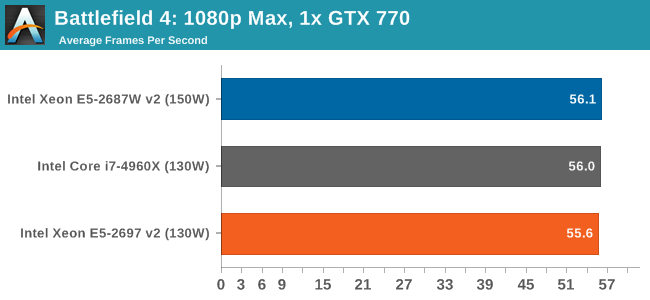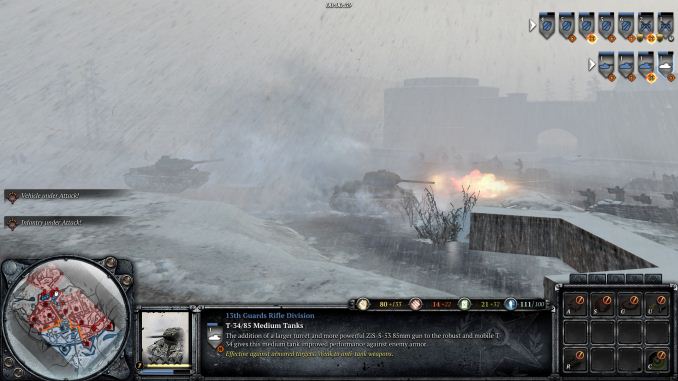Intel Xeon E5-2697 v2 and Xeon E5-2687W v2 Review: 12 and 8 Cores
by Ian Cutress on March 17, 2014 11:59 AM EST- Posted in
- CPUs
- Intel
- Xeon
- Enterprise
Sleeping Dogs
Sleeping Dogs is a benchmarking wet dream – a highly complex benchmark that can bring the toughest setup and high resolutions down into single figures. Having an extreme SSAO setting can do that, but at the right settings Sleeping Dogs is highly playable and enjoyable. We run the basic benchmark program laid out in the Adrenaline benchmark tool, and the Xtreme (1920x1080, Maximum) performance setting, noting down the average frame rates and the minimum frame rates.

| Sleeping Dogs, 1080p Max | ||
| NVIDIA | AMD | |
| Average Frame Rates |
|
|
| Minimum Frame Rates |
|
|
The lower frequency of the 12-core Xeon sometimes puts it behind in our Sleeping Dogs testing, usually in multiple GPU results such as 3x HD 7970 where it is 15 FPS behind both the i7-4960X and E5-2687W v2
Company of Heroes 2
The final gaming benchmark is another humdinger. Company of Heroes 2 also can bring a top end GPU to its knees, even at very basic benchmark settings. To get an average 30 FPS using a normal GPU is a challenge, let alone a minimum frame rate of 30 FPS. For this benchmark I use modified versions of Ryan’s batch files at 1920x1080 on Medium. COH2 is a little odd in that it does not scale with more GPUs.

| Company of Heroes 2, 1080p Max | ||
| NVIDIA | AMD | |
| Average Frame Rates |
|
|
| Minimum Frame Rates |
|
|
COH2 also acts somewhat CPU agnostic, although the higher frequency Xeon does have a small negligable boost over the E5-2697 v2. In all circumstances, the i7-4960X is competitive.
Battlefield 4
The EA/DICE series that has taken countless hours of my life away is back for another iteration, using the Frostbite 3 engine. AMD is also piling its resources into BF4 with the new Mantle API for developers, designed to cut the time required for the CPU to dispatch commands to the graphical sub-system. For our test we use the in-game benchmarking tools and record the frame time for the first ~70 seconds of the Tashgar single player mission, which is an on-rails generation of and rendering of objects and textures. We test at 1920x1080 at Ultra settings.

| Battlefield 4, 1080p Max | ||
| NVIDIA | AMD | |
| Average Frame Rates |
|
|
| 99th Percentile Frame Rates |
|
|
As we add more GPUs, AMD and NVIDIA act differently. With NVIDIA, more MHz gets better frame rates, whereas with AMD more cores wins out.
Conclusions
It would seem that in our gaming benchmarks, the higher frequency E5-2697W v2 is the more obvious choice over the 12-core E5-2697 v2. However in almost all circumstances, they perform on part with or below the i7-4960X, thus suggesting that our games tested cannot take advantage of more threads.












71 Comments
View All Comments
Ian Cutress - Monday, March 17, 2014 - link
Corrected :) The test setup for the A10-7850K is the same as the Kaveri review. ASRock FM2A88X Extreme6+ with extra cooling, 2x8GB DDR3-2133 (i.e. rated processor speed).Nintendo Maniac 64 - Monday, March 17, 2014 - link
So stock clocks with turbo enabled on Win7 64bit SP1 w/ core parking update?Ian Cutress - Monday, March 17, 2014 - link
Correct.mattchid - Monday, March 17, 2014 - link
I have two 2697v2 I was gifted, and while I'm only running one on an x79 MB, I have two questions I can't find answers to elsewhere on the 2697 v2:1. Is the memory limited to 1866, even on motherboards supporting higher overclocks? I have tried to run memory above that speed (1866 memory that usually over clocks well) and the computer refuses to boot past the bios at that speed.
2. What would the performance gains be with both installed, in reference to multithreaded activities, like rendering, or even more rudimentary, like x264 or handbrake conversion? I would guess with single threaded activity, there would be no difference in performance, than one CPU.
psyq321 - Tuesday, March 18, 2014 - link
I have tested two generations of 2697 v2 (C0 and C1 stepping) and both refuse to accept anything above 1866 MHz. Practically, my old workhorse (dual 2687W) was much better in that regard and could run DDR3 @2133 MHz without any trickery.Although the CPU platforms (JakeTown and IvyTown) are pin-compatible for the EP series, high-core-count (HCC) EP IvyTowns have two separate memory controllers and I suppose this introduces regressions when it comes to "overclockability" of the RAM.
As for the #2, if you are running NUMA-aware multithreaded software that can spawn 24 or 48 threads, you can expect almost linear performance scaling with dual-CPU setups.
If the software is not NUMA aware, then there are performance drops that can be 30-50% (so you get, maybe, 1.5x speedup). If the software cannot get more than, say, 8 threads, then there would be no speedups (but even in this case you can start two separate processes and do two encoding sessions at once, and regain the 2x speedup)
CamdogXIII - Monday, March 17, 2014 - link
Typo in the gaming benchmarks. Under BF4, the button selection heading reads company of heroesIan Cutress - Tuesday, March 18, 2014 - link
Corrected :)iwod - Monday, March 17, 2014 - link
This doesn't really answer any question about the State of Xeon.So what exactly is difference between a Xeon E3- v3 and a Normal Top End Haswell Chip?
We have Broadwell soon ( in a few months? ) Are we suppose to get new Haswell E5 too? Isn't the Xeon E5 always one year behind the desktop counterpart, or are they slipping even more?
JlHADJOE - Monday, March 17, 2014 - link
Xeon E3 has ECC support, which is pretty cool.venk90 - Tuesday, March 18, 2014 - link
Ian, Could you post the AMD Kaveri CPU and GPU numbers to the respective bench sections of this website ? Makes comparisons a lot easier.